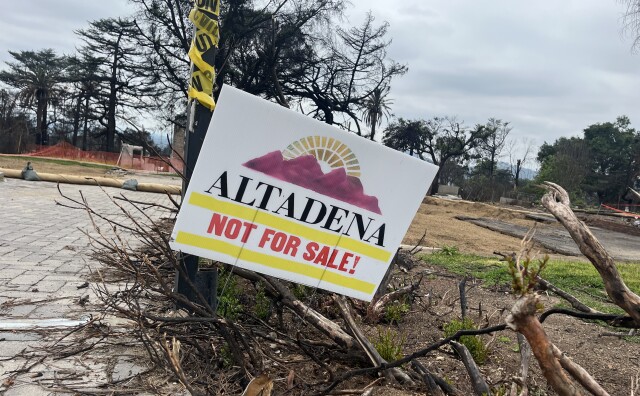With our free press under threat and federal funding for public media gone, your support matters more than ever. Help keep the LAist newsroom strong, become a monthly member or increase your support today.
This archival content was written, edited, and published prior to LAist's acquisition by its current owner, Southern California Public Radio ("SCPR"). Content, such as language choice and subject matter, in archival articles therefore may not align with SCPR's current editorial standards. To learn more about those standards and why we make this distinction, please click here.
Author James Ellroy Explores The Seedy Crimes Of 1953 In Photos
Crime writer James Ellroy and the L.A. Police Museum have come out with a new book exploring the seedy crimes of 1953 Los Angeles.
LAPD '53 combines James Ellroy's literary voice with over 80 real crime photos from the LAPD, each one unfolding in Ellroy's distinctive hard-boiled style into a sordid and unfortunate tale from 1953.
The idea for the book came about around four years ago. Los Angeles Police Museum executive director Glynn Martin said it was Ellroy's vision to do the book. Martin's role was to put the whole thing together, beginning with finding photos and cases. Initially, Martin's scope was anywhere from the 1920s to the 1950s, meaning he went through thousands of photos before 1953, a seemingly ill-fated year, emerged. "It just seemed like that cases from that year were unique and substantial," Martin said. Martin said that Ellroy said that people "dressed and acted better" back then.
One case that stuck with Martin was that of a San Fernando Valley man who murdered his wife by bludgeoning her with a croquet mallet. He then cut off her hands and took her body to Mexico, all with his three children in the car. The man was eventually captured in New Jersey, where he'd fled because he had family there he thought could help him raise his kids.
The gritty black and white photos have almost a surreal feel. In one photo, a detective kneels on the ground, pointing to chalk markings designating where a body was found.
"They say a picture's worth 1000 words, but they seem like they're worth 100,000 when James lends his talent," Martin said. Martin had to bring in transcribers for the book, as Ellroy still writes in longhand.
Accompanying the photo above of a detective kneeling over a chalk drawing, Ellroy writes:
Here's a rough one. There's one ray of hope. Sergeant Harry Hansen's on the job. That's him pointing to the chalk floor outline and the single word "head." Hansen was the lead detective on the celebrated ElizabethShort/Black Dahlia case of January '47. That case remains unsolved and hovers as Hansen's idee fixe. He's a great detective. If anyone can solve the Dahlia snuff, it's Homicide Harry. Now, it's 6/8/1953—and he's got a fucking hybrid baffler.
Ellroy himself has been particularly mystified by the still unsolved murder of Elizabeth Short.
Martin notes that the circumstances and names are accurate, though Elroy imbues the stories with his own personal style.
"This is in many ways a retrospective showing the vast difference in the car, the cops and the cribs—to say something James might say. They all have a vastly different look," he said.
Visitors to the Police Museum will get to see the evolution of the LAPD uniform, vehicles and the police commission, and learn about significant cases, including the 1963 kidnapping of two plainclothes officers as portrayed in The Onion Field.
At LAist, we believe in journalism without censorship and the right of a free press to speak truth to those in power. Our hard-hitting watchdog reporting on local government, climate, and the ongoing housing and homelessness crisis is trustworthy, independent and freely accessible to everyone thanks to the support of readers like you.
But the game has changed: Congress voted to eliminate funding for public media across the country. Here at LAist that means a loss of $1.7 million in our budget every year. We want to assure you that despite growing threats to free press and free speech, LAist will remain a voice you know and trust. Speaking frankly, the amount of reader support we receive will help determine how strong of a newsroom we are going forward to cover the important news in our community.
We’re asking you to stand up for independent reporting that will not be silenced. With more individuals like you supporting this public service, we can continue to provide essential coverage for Southern Californians that you can’t find anywhere else. Become a monthly member today to help sustain this mission.
Thank you for your generous support and belief in the value of independent news.

-
The Palisades Fire erupted on Jan. 7 and went on to kill 12 people and destroy more than 6,800 homes and buildings.
-
People moving to Los Angeles are regularly baffled by the region’s refrigerator-less apartments. They’ll soon be a thing of the past.
-
Experts say students shouldn't readily forgo federal aid. But a California-only program may be a good alternative in some cases.
-
Distrito Catorce’s Guillermo Piñon says the team no longer reflects his community. A new mural will honor local leaders instead.
-
The program is for customers in communities that may not be able to afford turf removal or water-saving upgrades.
-
More than half of sales through September have been to corporate developers. Grassroots community efforts continue to work to combat the trend.







